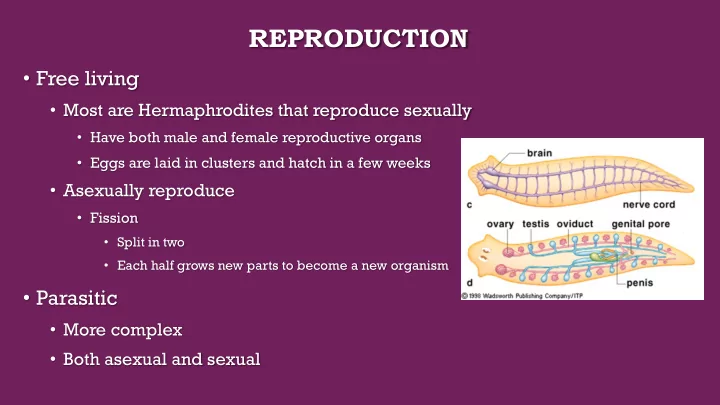

REPRODUCTION • Free living • Most are Hermaphrodites that reproduce sexually • Have both male and female reproductive organs • Eggs are laid in clusters and hatch in a few weeks • Asexually reproduce • Fission • Split in two • Each half grows new parts to become a new organism • Parasitic • More complex • Both asexual and sexual
GROUPS OF FLATWORMS • The three main groups of flatworms are • Turbellarians • Flukes • Tapeworms • Most turbellarians are free-living. • Most other flatworm species are parasites.
TURBELLARIANS • Class Turbellaria • Vary in colour, form and size • Free living • Marine and fresh water • Bottom dwellers • Most species live in the sand or mud under stones and shells. • Planarians • Freshwater worms
FLUKES • Class Trematoda • Parasitic flatworm • Most infect internal organs of host • Some infect externally • Mouth, gills, skin
LIFE CYCLE OF A BLOOD FLUKE • Lives in multiple hosts • Primary host is human • Reproduces sexually
TAPEWORMS • Class Cestoda • Long flat parasitic worms • Live in intestines of host • No digestive tract • Food in intestine has already been digested • Food absorbed through body walls • Tapeworm removed from dog
STRUCTURE • Structure • Scolex • Contains suckers and hooks • Used to attach to intestine wall of host to absorb nutrients
• Proglottids • Behind scolex • Makes up most of body • Mature proglottids contain both male and female reproductive organs • a section of the tapeworm body Contains male and female reproductive organs • Able to self- or cross-fertilize • The Proglottids at the end of the body break off and pass out in feces of host • Each Proglottids contains many fertilized eggs
LIFE CYCLE OF A TAPEWORM
FAD DIETS IN THE 1900’S
Recommend
More recommend